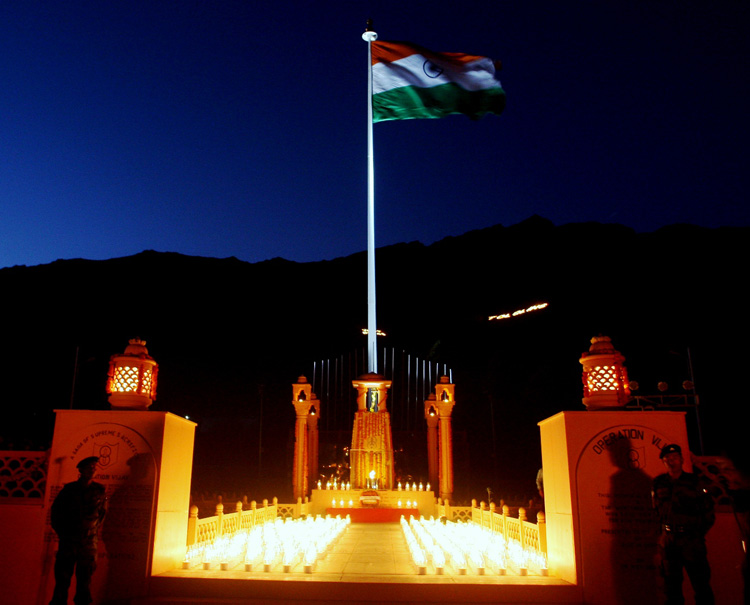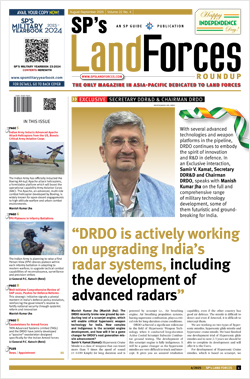INDIAN ARMED FORCES CHIEFS ON OUR RELENTLESS AND FOCUSED PUBLISHING EFFORTS

The insightful articles, inspiring narrations and analytical perspectives presented by the Editorial Team, establish an alluring connect with the reader. My compliments and best wishes to SP Guide Publications.

"Over the past 60 years, the growth of SP Guide Publications has mirrored the rising stature of Indian Navy. Its well-researched and informative magazines on Defence and Aerospace sector have served to shape an educated opinion of our military personnel, policy makers and the public alike. I wish SP's Publication team continued success, fair winds and following seas in all future endeavour!"

Since, its inception in 1964, SP Guide Publications has consistently demonstrated commitment to high-quality journalism in the aerospace and defence sectors, earning a well-deserved reputation as Asia's largest media house in this domain. I wish SP Guide Publications continued success in its pursuit of excellence.
- Appointments Committee of Cabinet approves one-month extension in service of Chief of the Army Staff
- Prime Minister witnesses 'Bharat Shakti' – a Tri-Services Firing and Manoeuvre Exercise in Pokhran, Rajasthan
- Interim Defence Budget 2024-25 — An Analysis
- Union Defence budget 2024
- Indian Army: In quest of greater firepower and policy recommendations for gaps
- Indian Army Annual Press Conference 2024
- Tata Boeing Aerospace Delivers 250 AH-64 Apache Fuselages, Manufactured in India
Another Kargil Anniversary
 |
By Lt. General P.C. Katoch (Retd) Former Director General of Information Systems, Indian Army |

Come July 26, India will celebrate Op 'Vijay' Diwas; another anniversary synonymous with the date of culmination of the Kargil Conflict during 1999. There will be wreath laying at Amar Jawan Jyoti at India Gate, and much bigger ceremony to pay homage at the Kargil War Memorial at Dras in J&K in presence next of kin of martyrs of Kargil Conflict and representatives of units that had taken part in the operations. But more important is to look back and examine what lessons did we learn, and to what extent. There is no denying Kargil intrusions were at such massive scale that Pakistan had made ingress over weeks. There was complete intelligence failure. In fact, had the Pakistanis not ambushed and captured the patrol led by Captain Saurabh Kalia, the surprise would have prolonged much longer - closer to winters, and had both road axes closed with snow, India's response would have stretched over many months, causing much embarrassment. Had our intelligence been active, many of the 530 lives lost could have probably been saved. But where are we today in terms of intelligence-cum-surveillance means against China and Pakistan? Yes, UAV's are available in some sectors but do we have 24x7 surveillance astride the LoC and LAC like China has – the answer is no. Even the MAVs are yet to be introduced into the Army. What about trans-border intelligence? Are we still dependent on a strategic partner to give us precise coordinates for 'surgical strike'? Why don't we understand that covert operations, and ntelligence operations are not publicized – do Pakistan, US, Russia, Israel, UK publicize operations by ISI, CIA, KGB, Mossad and Mi-6 respectively? During the Kargil Conflict, telephone conversation between General Musharraf and his Chief of General Staff were intercepted while Musharraf was on a visit to China. This conversation was made public.
Videos of surgical strikes which have heavy elements of intelligence were made public and now an Afghan national who was ISIS agent and under surveillance by our intelligence agencies for 18 months and then arrested has been made public. All such actions violate the unwritten code of intelligence operations and special operations that are not to be made public; publicity give away capability, technical prowess, and modus operandi, all of which are dangerous for conduct of similar operations in future. After the Kargil Conflict, intelligence got an excellent boost with raising of Army's Technical Support Division (TSD) but this was disbanded because of politicians fearing their skeletons would get exposed. Unfortunately, the advantages of TSD were never projected by successive Army Chiefs. Chinese intrusion in Tuting area in December last year was discovered by chance by a hunter, where China had already constructed a 1.25 km jeepable road on our side of the LAC under three feet of snow. So how are we different from 1999, where a local Ladakhi happened to observe Pakistani intrusions in a particular area? We have also not fully grasped the importance of locals in the border areas. Bishing village, closest to the Tuting intrusion area does not have a motorable road because of the "norm" of not providing roads for villages less than 100 population under the Pradhan Mantri Gram Sadak Yojna (PMGSY) and since we bother little about border infrastructure, it was this hunter who having seen the Chinese road building activity alerted the ITBP, who in turn informed the Army. Significantly, the Army tool 19 hours to reach the intrusion area.
Shortcomings in our defence preparedness including border infrastructure needs to be plugged especially in the wake of the growing asymmetry vis-à-vis China. Though Arunachal Pradesh has small population and consequently small vote-bank, had Prime Minister Modi tasked Union Minister Nitin Gadkari also with development of border infrastructure, perhaps the change would have been miraculous in the last four years. Bureaucratic advice is always available that China will undertake no such action due economic reasons especially after Wuhan, but remember Geng Shuang, Chinese Foreign Ministry spokesman stating on January 3, 2018 that China "never acknowledged" the existence of Arunachal Pradesh. Ironically under NDA II, defence allocations continue to be the lowest since 1962. The Kargil Committee gave recommendations ranging from strategic reorganization of intelligence, reducing Army's commitment in counter-insurgency commitments, establishment of a Chief of Defence Staff, improving operating procedures and inter-services cooperation, right down to tactical elements like equipment acquisition, including a lighter rifle. However, the politico-bureaucratic nexus has not permitted much of what was required. Forget CDS, even the reorganization of MoD has been shied away from. Our political hierarchy must understand: the China-Pakistan nexus is getting stronger by the day; Pakistan is strategically much more important to China vis-à-vis India; objectives of China and Pakistan coalesce with respect to India – and the noose around India is tightening; economy and soft power are not effective unless backed by hard power; having consolidated in SCS, China is focused on IOR, and; Xi Jinping has stated he will not lose an inch of territory – which includes China's illegal claims. Finally, we need to remember what Zbiginew Brezinsky wrote in his book 'The Grand Chess Board, wherein he said, "China and India are destined by Geography to be Rivals. With venerable culture and vast population, are likely to compete with each other for resources and influence". This is a fact we must not ignore.





